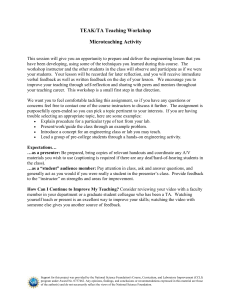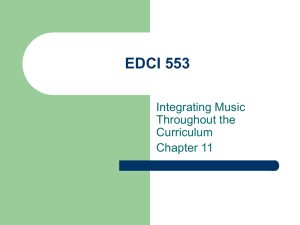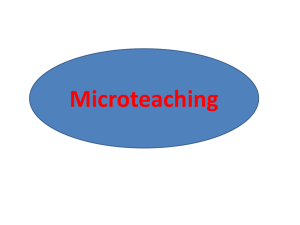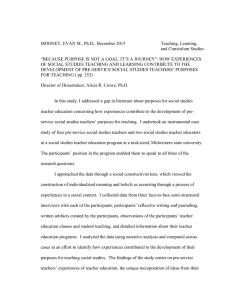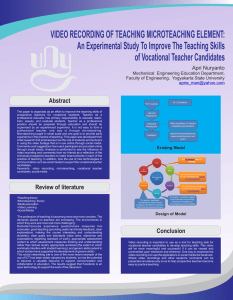PRE-SERVICE TEACHERS` OPINIONS ABOUT THE MICRO
advertisement
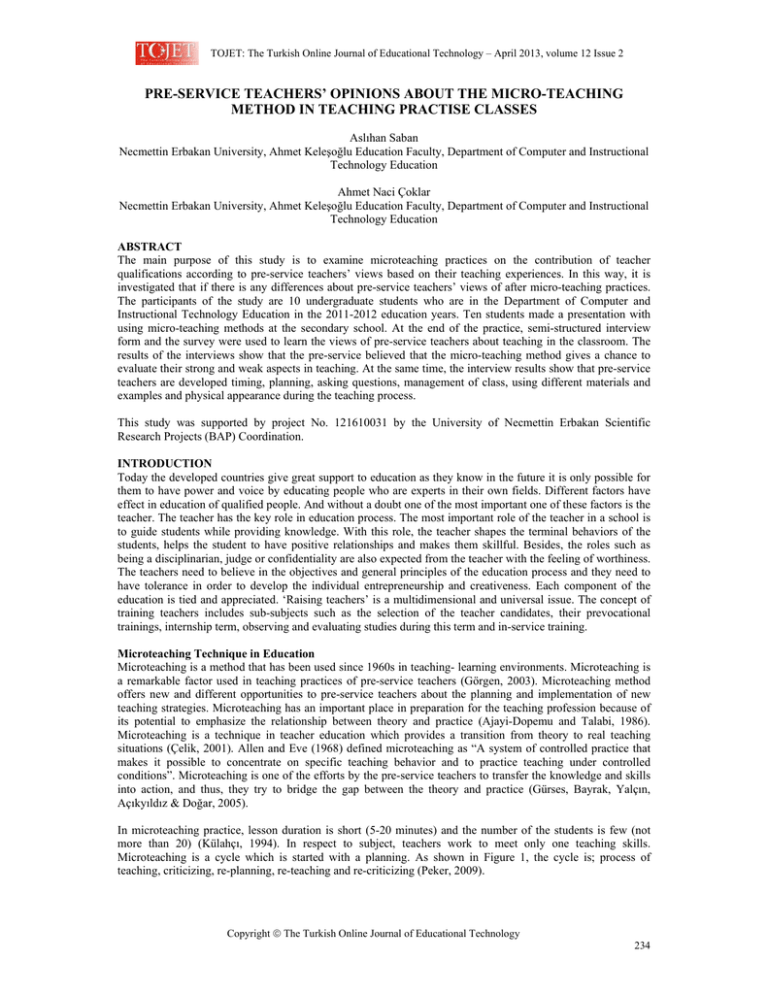
TOJET: The Turkish Online Journal of Educational Technology – April 2013, volume 12 Issue 2 PRE-SERVICE TEACHERS’ OPINIONS ABOUT THE MICRO-TEACHING METHOD IN TEACHING PRACTISE CLASSES Aslıhan Saban Necmettin Erbakan University, Ahmet Keleşoğlu Education Faculty, Department of Computer and Instructional Technology Education Ahmet Naci Çoklar Necmettin Erbakan University, Ahmet Keleşoğlu Education Faculty, Department of Computer and Instructional Technology Education ABSTRACT The main purpose of this study is to examine microteaching practices on the contribution of teacher qualifications according to pre-service teachers’ views based on their teaching experiences. In this way, it is investigated that if there is any differences about pre-service teachers’ views of after micro-teaching practices. The participants of the study are 10 undergraduate students who are in the Department of Computer and Instructional Technology Education in the 2011-2012 education years. Ten students made a presentation with using micro-teaching methods at the secondary school. At the end of the practice, semi-structured interview form and the survey were used to learn the views of pre-service teachers about teaching in the classroom. The results of the interviews show that the pre-service believed that the micro-teaching method gives a chance to evaluate their strong and weak aspects in teaching. At the same time, the interview results show that pre-service teachers are developed timing, planning, asking questions, management of class, using different materials and examples and physical appearance during the teaching process. This study was supported by project No. 121610031 by the University of Necmettin Erbakan Scientific Research Projects (BAP) Coordination. INTRODUCTION Today the developed countries give great support to education as they know in the future it is only possible for them to have power and voice by educating people who are experts in their own fields. Different factors have effect in education of qualified people. And without a doubt one of the most important one of these factors is the teacher. The teacher has the key role in education process. The most important role of the teacher in a school is to guide students while providing knowledge. With this role, the teacher shapes the terminal behaviors of the students, helps the student to have positive relationships and makes them skillful. Besides, the roles such as being a disciplinarian, judge or confidentiality are also expected from the teacher with the feeling of worthiness. The teachers need to believe in the objectives and general principles of the education process and they need to have tolerance in order to develop the individual entrepreneurship and creativeness. Each component of the education is tied and appreciated. ‘Raising teachers’ is a multidimensional and universal issue. The concept of training teachers includes sub-subjects such as the selection of the teacher candidates, their prevocational trainings, internship term, observing and evaluating studies during this term and in-service training. Microteaching Technique in Education Microteaching is a method that has been used since 1960s in teaching- learning environments. Microteaching is a remarkable factor used in teaching practices of pre-service teachers (Görgen, 2003). Microteaching method offers new and different opportunities to pre-service teachers about the planning and implementation of new teaching strategies. Microteaching has an important place in preparation for the teaching profession because of its potential to emphasize the relationship between theory and practice (Ajayi-Dopemu and Talabi, 1986). Microteaching is a technique in teacher education which provides a transition from theory to real teaching situations (Çelik, 2001). Allen and Eve (1968) defined microteaching as “A system of controlled practice that makes it possible to concentrate on specific teaching behavior and to practice teaching under controlled conditions”. Microteaching is one of the efforts by the pre-service teachers to transfer the knowledge and skills into action, and thus, they try to bridge the gap between the theory and practice (Gürses, Bayrak, Yalçın, Açıkyıldız & Doğar, 2005). In microteaching practice, lesson duration is short (5-20 minutes) and the number of the students is few (not more than 20) (Külahçı, 1994). In respect to subject, teachers work to meet only one teaching skills. Microteaching is a cycle which is started with a planning. As shown in Figure 1, the cycle is; process of teaching, criticizing, re-planning, re-teaching and re-criticizing (Peker, 2009). Copyright © The Turkish Online Journal of Educational Technology 234 TOJET: The Turkish Online Journal of Educational Technology – April 2013, volume 12 Issue 2 Figure 1. Stages of Microteaching In the process of cycle, pre-service teachers prepared the lesson plan that the subject is determined before. In teaching stage of cycle, the pre-service teachers perform micro lessons to real students that were planned and prepared by them. Also, lectures are recorded by video camera or portable receivers. After that pre-service teachers watch and hear by self from the video recording at the end of the lecture. In critique stage, pre-service teachers’ micro lessons are reviewed, discussed, analyzed and evaluated (Çelik, 2001). Pre-service teachers take criticisms and suggestions from the guide teacher and their friends. According to the suggestions, pre-service teachers prepared the lesson plan again and re-teach micro lessons to same group. Also, the second micro lessons are recorded by video camera or portable receivers. After the watching second micro lessons from recording, the teacher and peers present their critiques which are about the worst or better sides between first and second micro lessons. The end of the cycle, microteaching practices give pre-service teachers have opportunity to evaluate their strengths, weaknesses and try to improve weak sides ( Kpanja, 2001; Sarı, Sakal & Deniz, 2005; Ekşi, 2012). It seemed that most of the fears of teachers disappeared at the end of the application, and extended micro-teaching practices are seen to be equivalent to a one-year trainee teacher is emphasized (Peker, 2009). The Purpose and Importance of Microteaching Microteaching was first used in medicine at Stanford University in 1960s to promote the quality of students (Cruickshank & Metcalf, 1993) and then it was applied in teacher training for the same purpose (He & Yan, 2011). Görgen (2003) states that pre-service teachers can experience real teaching situations with microteaching, and they have the opportunities to transfer their teaching knowledge into practice. Thus, it can be said that microteaching can provide the possibility of forming a trial situation for teaching activities. In microteaching, pre-service teachers find opportunities to develop skills to prepare lesson plans, choose teaching goals, take students’ attention, speak in front of group, ask questions, managing time effectively, and assessment techniques (Kılıç, 2010). In this way, pre-service teachers improve their classroom management skills. It provides expert supervision and a constructive feedback and above all if provides for repeated practice without adverse consequences to the teacher or his students (Ananthakrishnan, 1993). The micro-teaching practices improved both student’s and teachers' self-confidence and the teaching skills are emphasized (Şen, 2009; Şen, 2010). There have been researched indicating that microteaching is useful, pre-service teachers can gain much in case of using microteaching and that their views on teaching can improve much with the help of microteaching. Görgen (2003), in his research with 24 pre-service teachers, found out that the views of pre-service teachers pose some differences before and after teaching practice. Similarly, He & Yan (2011), in the research with 60 stıdents, indicated that microteaching has remarkable effect on the professional development of the students. Küçükoğlu, Köse, Taşgın, Yılmaz, & Karademir (2012) carried out a research to determine the effect of microteaching on teaching skills. It was an experimental study with 40 pre-service teachers. The findings of the research show that the pre-service teachers who applied microteaching in training had fewer challenges than those who had no microteaching activities. This implies that microteaching contributes positively to the teaching skills of pre-service teachers. Copyright © The Turkish Online Journal of Educational Technology 235 TOJET: The Turkish Online Journal of Educational Technology – April 2013, volume 12 Issue 2 Microteaching Application Process Ananthakrishnan (1993) summarized microteaching process in nine stages; • Lesson planning: having clear cut objectives, and an appropriate planned sequence. • Set induction: the process of gaining pupil attention at the beginning of the class. • Presentation: explaining, narrating, giving appropriate illustrations and examples, planned repetition where necessary. • Stimulus variation: avoidance of boredom amongst students by gestures, movements, focusing, silence, changing sensory channels etc. • Proper use of audio: visual aids. • Reinforcement: recognizing pupil difficulties, listening, encouraging pupil participation and response. • Questioning: fluency in asking questions, passing questions and adapting questions. • Silence and nonverbal cues (body language) • Closure: method of concluding a teaching session so as to bring out the relevance of what has been learnt, its connection with past learning and its application to future learning. Problem Statement and Purpose The aim of the microteaching practice research is to prepare pre-service teachers better by themselves in teaching practice lesson. As a result of the process of preparation, pre-service teachers prepare and present the lesson with less anxiety and feeling comfortable are the feelings that are expected to be observed in the class. The main purpose of this study is to examine micro-teaching practices on the contribution of teacher qualifications according to pre-service teachers’ views based on their teaching experiences. METHODOLOGY This qualitative research aims to compare the views of the prospective students before and after microteaching application. Participants Participants were 10 students of the Computer and Instructional Technology Education Program in the Faculty of Education in Necmettin Erbakan University. In the research, easy accessible sample technique was used. This technique increases the speed and it is preferred when the sample is easily accessible by the researcher (Yıldırım & Şimşek, 2006). The data were obtained from 10 pre-service teachers who were willing to be involved in the research after being exposed to microteaching application by the researchers. Research Instrument In this study, the tool used to gather data with semi structured interview form. End of the semester, 8 questions were asked to pre-service teachers to evaluate microteaching about computer training. After the microteaching period in which microteaching was applied as a part of teacher training lessons, eight different questions about computer teaching were asked to the participants so that they could evaluate the microteaching application they already had. Data Analysis The data were obtained with the help of the interview with the participants. The data then were transferred into the computer to form the digital data. Then content analysis was used with the percentage and frequency values. FINDINGS The findings resulting from the answers given by the pre-service teachers for the questions in the semistructured interview form are given below. The Views of the Pre-service Teachers Regarding Their Concerns about the Application The first question was “Did you think that you have difficulties in teaching computer before you started to teach in practice schools?”. The Majority of the participants (%80) remark that there will be challenges for them. 2 out of 10 students think that they will not have any difficulties. 8 students think they will have problems. The sample statements for this question are given below. “Yes, I do. Every student is in different level so I can’t decide with which level I have to start.” (Y.Ş.A.) “Yes, people believe that every student know how to use a computer. Therefore, I think that students don’t want to listen to me.” (A.G.) Copyright © The Turkish Online Journal of Educational Technology 236 TOJET: The Turkish Online Journal of Educational Technology – April 2013, volume 12 Issue 2 “Yes. I was thinking there were a lot of things about the computer; I didn’t believe that I have enough control.” (A.C.) “No. I thought that I had enough technical information and self-efficacy in usage of computer so I shouldn’t be so excited.” (M.T.H.). The Views of the Pre-service Teachers Regarding the Contribution of Microteaching Videos The second question was “Do you think that watching the presentation videos of the microteaching practices with your friends provides benefits to you?”. In addition, there were some drills to explore the benefits. 90% of the students stated that video watching is useful for them. Also, they said that it is easier to evaluate advantages and disadvantages of microteaching practices. Only one student (%10) thinks that video watching altogether is not useful. The sample statements for this question are given below. “Sure. Taking other peoples’ ideas objectively provides recognizing weak sides of my own.” (E.T.) “Yes I do. It is so useful to recognize my own and others’ weaknesses and fix them. This situation increases my level of success.” (S.K.) “Although we have a lot of mistakes during the lecture, we can’t realize them because of the excitement we have. We have a chance to watch ourselves in good or bad manner. After that we will not do the same mistakes again.”(B.Ç.) “Yes, I believe that watching videos of microteaching application contribute us in a good way. I could see my mistakes in videos very clearly.” (Y.Ş.A.) “It must have contributed but it hadn’t. The main reason of this is my friend’s hesitation to tell others’ weak sides.” (M.T.H.) The Views of the Pre-service Teachers Regarding the Difference between the First and Second Presentations The question was “Do you think that there is any difference between your first and second presentation?”. Thus, the researchers aimed to draw results about the importance of the application. All students in the research think that their second presentation is more successful than the first one. “In first presentation, I was inexperienced. In the second one I was more comfortable and didn’t do the same mistakes.” (A.G.) “Yes, I was inexperienced and excited in the first presentation. I felt more like a teacher in the second one.” (A.C.) “I was very excited in the first presentation and I couldn’t adjust my voice. After the first presentation, according to the feedbacks I lessened my excitement and control my gesture better in the second presentation.” (S.Ç.) “Sure. The practice is so different then the real teaching. Actually, we have a 4 year education at the university but it was so exciting to feel like a teacher with real students in the real school. I think that correcting my mistakes, providing class control, having dialogues with students is better in the second presentation.” (S.K.) “I believe that the first and second presentations were so different. I saw my mistakes in the first presentation and I try not to make them in the second presentation.” (Y.Ş.A.) The Views of the Pre-service Teachers Regarding the Contribution of the Videos of Other Classmates In order to find out the effect of watching the each other’s videos on their teaching experience, the question “Do you think that watching the presentation videos with using microteaching technique of your friends contributes you?” was asked. All pre-service teachers participated in research think that watching the presentation videos which use microteaching technique of other pre-service teachers was beneficial to them. For example; “I think. As a result, technology renews itself every day and we as a teacher of technology use it in every lecture. If other friends watch videos, they can have an idea of how to use technology in the lecture and organize it.” (S.Ç.) Copyright © The Turkish Online Journal of Educational Technology 237 TOJET: The Turkish Online Journal of Educational Technology – April 2013, volume 12 Issue 2 “I think that it is helpful my friends to assessment themselves objectively.” (E.T.) “Of course. We discuss what mistakes did our friends and how could they correct them?” (H.Ö.) “After seeing the weaknesses of my other friends also I noticed that I have the same mistakes. I think that we corrected our mistakes in unity of common view.” (Ç.S.) The Views of the Pre-service Teachers Regarding the Microteaching Method for Teaching Experience The question “What do you think about the use of the microteaching method in the teaching practice lesson?” was asked to evaluate the microteaching method. All pre-service teachers who participated in the research think that the microteaching method of watching themselves and their friends objectively, seeing their mistakes and correcting it, should be used in future lectures. “It is an application to all pre-service teachers do. It is a useful practice to evaluate and correct our weakness.” (S.K.) “It helped me to see my mistakes and be careful to avoid the same mistakes. I think that it is useful for every pre-service teacher.” (B.Ç.) “I think that it is a useful practice. We have a lot of experience when we are watching our friends’ activity in the classroom.” (Y.Ş.A.) “The method should be applied. Watching yourself in a second eye provides a good opportunity to develop oneself. Watching other friends can prevent possible deficiencies.” (M.T.H.) “First of all, I didn’t have a positive look. After the application, I think that it is useful practice for teachers to see themselves through the eyes of someone else.” (A.C.) The Views of the Pre-service Teachers Regarding the Possible Challenges/Limitations of Microteaching Application In order to find out the views of the pre-service teachers regarding the possible challenges faced during microteaching application, the question “What are some limitations of the application of micro-teaching techniques of teaching practice?” was asked. The pre-service teachers who participated in the research said that the idea of recording in microteaching practice increased their excitement and anxiety. “The fact that you are in an actual classroom environment, with real students, and the conscious knowledge that you are a teacher together with the responsibility this gives you is all very good but the fact that the lesson is being recorded increases levels of excitement and anxiety. I think this is the only limitation. (S.K.) “Pre-service teachers can’t behave spontaneously due to the idea of recording with a camera. The recording may be reasons why students can’t behave naturally.” (B.Ç.) “We are excited about being recorded during the lecture and watching the recording after the lecture.” (Y.Ş.A.) “The camera makes us nervous and that can be a problem from the first moment but I don’t think that it has very limitations. As a result, practice is better than theory every time.”(M.T.H.) The Suggestions of the Pre-service Teachers Regarding the Microteaching Application The suggestions of 10 participants were considered to contribute to better applications. The teacher candidates who took part in the research using micro-teaching techniques on their teacher candidate friends should have a command over the tools and equipment as well as the materials before the class commences, they should behave in a relaxed and natural way, and they should listen to the criticism and try to make amend their deficiencies. “The pre-service teachers, who are implementing microteaching, should have technical and formation knowledge. First of all we must be willing to do this and arrange the necessary equipment and materials before the lecture.” (S.K.) “Pre-service teachers can’t behave spontaneously due to the idea of recording with a camera. They should behave naturally.” (B.Ç.) Copyright © The Turkish Online Journal of Educational Technology 238 TOJET: The Turkish Online Journal of Educational Technology – April 2013, volume 12 Issue 2 “Listen to the criticism of your friends so you don’t make the same mistakes and correct your weakness in other lectures.” (Y.Ş.A.) “It will be beneficial to students if they try to minimize the fact that they are going to be recorded and behave naturally.” (A.G.) “When they give the lecture, they should feel like a teacher not a student. It will be more efficient.” (S.Ç.) The Suggestions of the Pre-service Teachers towards Academic Staff To find out the suggestions, the question “What is your suggestion to advisor of academic staff about the implementation of the microteaching method?” was asked. The teacher candidates who took part in the research suggest to the faculty member advisers using micro-teaching techniques in the teaching application classes to use this technique to help the students relax and behave normally whilst giving the lesson, to give constructive criticism, and to enlighten teacher candidates on the topic of micro-education techniques. “As we found it beneficial to sit and watch the recording that our teacher made via the video camera with our other teacher candidate friends I can make a similar suggestion to other faculty member advisors.” (Ç.S.) “Advisor of academic staffs should help students relax during the recording. They should help students behave naturally. In addition, I think that they should make positive criticism to students without hurting their selfefficacy during the evaluation of microteaching practice.” (B.Ç.) “The criticism should be positive. They should be careful about this while they are watching the recording.” (Y.Ş.A.) “I suggest that they should motivate students. Also, they should provide the necessary equipments and information to the students.” (A.C.) “Before the implementation, advisor of academic staff should make a pre-speech about the advantages, disadvantages and objects of microteaching practice. They should use constructive and polite language during the criticism.” (E.T.) RESULTS AND CONCLUSION Microteaching is an important education component that gives chances of teaching practice to pre-service teachers (Allen and Wang, n.d.). Therefore, microteaching presents advantages like self confidence, seeing and fulfilling the shortcomings, learning different methods and techniques (Ananthakrishnan, 1993). So, the place of microteaching in education is important. This is a result indicated by different researches (He & Yan, 2011; Peker, 2009; Güngör, 2003). However, doing more researches on microteaching applications by pre-service teachers will contribute positively to this lesson to go on more usefully and efficiently. To this end, this research was carried out with 10 participants and following results came out. Pre-service students at the department of computer teacher training, as a result of microteaching activity, remark that they will have challenges in teaching. That’s to say, they say that they will have some kind of teaching anxiety following teaching experience. Regarding the microteaching application, majority of the students agree that video watching is useful. Similarly, all the participants state that watching the videos of all classmates together contributes much to eliminate the concerns mentioned above. These two findings are in parallel with the findings of other researches on the usefulness of video watching (Şen, 2010; Hauge & Norenes, 2009; Lazarus & Olivero, 2009). The participants sate that there is difference between their first and second presentations and the second presentations indicate that they are more experienced and thus they make fewer mistakes. Another finding is that all the pre-service teachers find that microteaching application in useful and essential. Watching their own videos and friends’ videos helps them to see what they do right or wrong, and this will contribute much to their future lessons. These two findings are in parallel with the ones that indicate that microteaching promotes their teaching experience and skills (He & Yan, 2011; Güngör, 2003). The pre-service teachers see “recording the lesson” as one of the possible problems. They state that recording causes concern and excitement and this is a problem for them. Ananthakrishnan (1993) agrees that recording can be a problem for the students but it is necessary for observation. The last parts of the questions are related with the suggestions of the students towards microteaching application and academic staff. The pre-service teachers stress on the importance of equipment use in the class as well as lesson materials before starting the lesson. Flexibility in the class is another point mentioned by the participants. As for the suggestions for academic staff, they should help the students to feel comfortable and relaxed during microteaching. Their criticism should be Copyright © The Turkish Online Journal of Educational Technology 239 TOJET: The Turkish Online Journal of Educational Technology – April 2013, volume 12 Issue 2 constructive and helpful. Similarly, Peker (2009) and Külahçı (1994) suggest that academic staff should be a guide while planning microteaching and they should help them to feel relaxed. Based on these descriptions and findings, microteaching method in school experience is the expansion of all the departments at the university, the fact that particularly the teaching profession can be said to be beneficial. However, the method of micro-teaching practices, additional time should be provided for the preparation of preservice teachers. Pre-service teachers acquiring knowledge and skills at faculty is an effective way, candidates should be concentrated in the profession, should see himself as a teacher, working compatible with teachers of practice, teaching topics and concepts in the curriculum, school administration and practice of teacher must help to pre-service teachers in any way, should provide a wide range of materials and the possibility of laboratory, faculty should take serious application of pre-service teachers, practice of teacher should follow pre-service teachers at the school. REFERENCES Ajayi-Dopemu, Y. & Talabi, J. K. (1986). The Effects of Videotape Recording on Microteaching Training Techniques for Education Students. Journal of Educational Television, 12 (1), 39-44 Allen D.W. & Wang, W. (n.d.). Microteaching ‐ The New Microteaching: Simplified, Variants of Microteaching,Microteaching Models of Teaching Skills, Microteaching Courses. Retrieved October 1, 2012, from http://education.stateuniversity.com/pages /2227/Microteaching.html. Allen, D. W. & Eve, A. W. (1968). Microteaching. Theory into Practice, 7(5), 181-185. Ananthakrishnan N. (1993). Microteaching as a Vehicle of Teacher Training--Its Advantages and Disadvantages. Journal of Postgrad Medicine.142-143. Cruickshank, D., & Metcalfe, K. (1993). Improving Preservice Teacher Assessment Through On-Campus Laboratory Experiences. Theory and Practice 32 (2), 86-92. Çelik, Ş. (2001). The Attitudes of The Student Teachers Towards Microteaching Technique As A Tool For Reflection In A Teacher Education Programme. (Unpublished master's thesis). University of Uludag, Bursa. Görgen, İ. (2003). The Effect of Microteaching Practises on Student Teachers’ Views Of Giving Lessons In The Classroom. Journal of Hacettepe University Education Faculty, 24, 56-63. Gürses, A., Bayrak, R., Yalçın, M., Açıkyıldız, M., & Doğar, Ç. (2005). Investigation of Effectiveness of Microteaching at Practicum. Kastamonu Education Journal, 13 (1), 1-10. Hauge, T.E. & Norenes, S.0. (2009) Changing Teamwork Practices: Videopaper as a Mediating Means for Teacher Professional Development, Technology, Pedagogy and Education. 18 (3), pp. 258-268. He, C. & Yan, C. (2011). Exploring Authenticity of Microteaching in Pre-Service Teacher Education Programmes. Teaching Education, 22(3), 291-302. Higgins, A & Nicholl, H. (2003). The Experiences of Lecturers and Students in The Use of Microteaching as A Teaching Strategy. Nurse Education in Plactice, 3, 220-227. Ekşi, G. (2012). Implementing an observation and feedback form for more effective feedback in microteaching. Education and Science, 37 (164), 267-282. Kılıç, A. (2010). Learner-Centered Micro Teaching in Teacher Education. International Journal of Instruction,3(1). Kpanja, E. (2001). A Study of Effects of Video Tape Recording in Microteaching Training. British Journal of Educational Technology, 32(4), 483-486. Küçükoğlu, A., Köse, E., Taşgın, A., Yılmaz, B. Y., & Karademir, Ş. (2012). The teacher candidates’ opinions regarding the effect of microteaching implementation on teaching skills. Journal of Educational Sciences Research, 2 (2), 19–32. Külahçı, Ş.G. (1994). Mikroöğretimde Fırat Üniversitesi Teknik Eğitim Fakültesi Deneyimi I. Model Geliştirme. Eğitim ve Bilim. 18(91), 12-23. Lazarus, E. & Olivero, F. (2009) ‘Videopapers as a tool for reflection on practice as initial teacher education’, Technology, Pedagogy and Education. 18 (3), pp. 258-268. Peker, M. (2009). Pre-service Mathematics Teacher Perspectives about the Expanded Microteaching Experiences. Journal of Turkish Educational Science, 7(2), 353-376. Sarı, Y., Sakal, M., & Deniz, S. (2005). The Effectiveness of Micro-teaching in Preschool Teacher Education. Gaziantep University Academic Information 2005 Conference, 112-113. Şen, A.İ. (2009). A Study of Effectiveness of Peermictoteaching in a Teacher Education program. Eğitim ve Bilim-Education and Science, 34(151), 165-174. Şen, A.İ. (2010). Effect of Peer Teaching and Micro Teaching on Teaching Skills of Pre-Service Physics Teachers. Eğitim ve Bilim-Education and Science, 35(155), 78-88 Yıldırım, A. & Şimşek, H. (2006). Qualitative Research Methods in Social Sciences. Ankara: Seckin Press. Copyright © The Turkish Online Journal of Educational Technology 240
